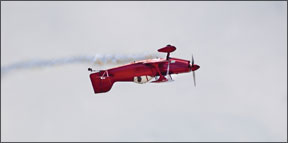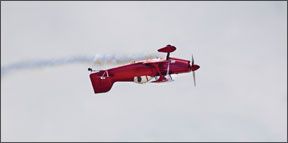At times during my training it often seemed the phrase most often uttered by the instructor was, “Watch your airspeed,” or its more-assertive variant, “Mind your speed.” If I didnt respond immediately, he continued his urgings, which usually escalating in volume and octave. That I eventually figured it out is evidenced by a piece of FAA paper in my pocket. And that was just the primary training.
In talks with other many fellow aviators, we found a shared memory of instrument instructors who seemed almost sadistic in their ability to distract us with airspeed warnings when all we wanted to do was center the needles or roll out on the

288
correct heading. We all recalled the endless grilling as our instructors drilled us on our ability to quote, hit and hold target speeds.
Of course, by the time wed hit instrument training, we all understood and absorbed the message-one which remains clear as crystal years later: Managing all of the multiple, simultaneous demands of flying becomes considerably easier once I could instinctively and automatically manage power and pitch to achieve the correct airspeed for each condition.
THE SPEED YOU NEED
Airspeed control, contends many a sage old aviator, is one hallmark of a truly good stick. Whether VMC or IMC, flights generally share all the same elements: Airspeed control is important for all conditions. From initial liftoff to the appropriate cruise-climb airspeed, the transition to level cruise flight at a desired airspeed, the ability to manage a descent-airspeed target, fly the pattern or approach while transiting toward touchdown, and then add back the knots needed to correct for varying winds on final, the pilots skill at smoothly hitting and transiting through the various airspeeds appropriate to each segment bears heavily on the safety and success of a flight.
Some of these speeds may be the same or very close to the same across the different phases of flight. For example, once I earned the instrument rating, I found I needed more speeds, those for holding segments and approach procedures come to mind. These turned out to be very similar to what I would fly in a busy VFR pattern in the same airplane.
At a casual glance, it might appear the only thing these different speeds have in common is the way we measure them. But, instead, they all are consistent with each flight regime and airplane configuration. The only real variables are that you use the combination of tools available in achieving the speed you need.
Power + Pitch = Airspeed
Those tools are simple, also. Regardless of where you come down in the debate over whether power or pitch controls altitude, the equation of power + pitch = airspeed (or performance) always holds true.
In other words, at any power setting there is another, corresponding pitch attitude yielding the desired airspeed: Leave alone the airplanes pitch attitude, add power and the aircraft will climb. And it will do so at the same airspeed seen in level flight, before power was added. The converse also is true: A reduction in power yields a loss of altitude, at the same airspeed.
Think about this for a moment: A climb at 90 knots differs in pitch and power from a 90-knot descent down an ILS, which also differs from flying at 90 knots a straight-and-level transition route from en route airspace to the final approach course. So, ultimately, each speed demands its own power and pitch combination-which can also vary according to the phase of flight-making for different combinations that yield the same speed but varying results.
The ability to find, learn and by rote repeat those power-plus-pitch settings to equal an airspeed and condition serves as a primary tool to manage a flight smoothly, from takeoff to touchdown, without erratic excursions from the desired targets.
Knowing which speed suits which phase of flight is but one step on the path to precise airspeed control. As we learn those speeds, we also need to ingrain the varying combinations of power and pitch that produce each airspeed for a specific flight condition: climbing, level flight, descending, approach. Then comes the final step: learning how to make the seemingly seamless transitions from one to the next as the flight unfolds.
The goal is to, as much as possible, know by muscle memory the pitch and power settings for each condition so the gauges in front of us serve largely to confirm and fine-tune our instinctive settings. Passengers may not know what quality it is that they like about flying with you, but dont be surprised if they mention how “smooth” you fly.
So Lets ID the Speeds
For our purposes, Ive opted to use speeds learned for a favorite common aircraft and an old friend, the humble Piper Cherokee 140. The box in the upper right of this page lists some of the speeds I used and the power/pitch combinations needed to achieve them. Its also worth acknowledging that, in large order, these same or similar speeds apply to other basic airplanes like the equally egalitarian Cessna Skyhawk.
Now, before you write to mention these numbers dont exactly match your PA-28 or 172, please remember these are examples of what worked on one Cherokee. Differences in tachs, airspeed indicators, pitot/static systems, props and powerplants add up. So, naturally, your numbers may vary.
Which brings up the first learning point: If you dont already know them by heart, you need to determine the important numbers for the plane you fly. You presumably know the numbers that your plane likes best for each of these phases of flight. Other speeds you might need/want are in the POH/AFM; you just need to write down the pitch/power combinations required to obtain them. If you dont know them already, you should learn each of the power/pitch combinations to hit those speeds for your bird. Besides, its a great excuse to go flying. More on this in a moment
Along the way, remember: No one should presume to tell you theres but one “correct” way to fly each of these speeds, because we all know differently. As the graph on the previous page in the sidebar on stability demonstrates, many speeds can be achieved through a variety of power/pitch combos. (At extremes, I suppose, all of them can be obtained-if not held for a length of time-at least once, before the wings come off.)
The numbers I used grew from trying to find the most-efficient power level for each step and a matching pitch-trim setting, whether 75 percent for cruise or any other phase. My logic? Minimal power settings save both fuel and wear and tear on that expensive little engine. Thus, my standard speed set included a cruise-climb combination; I rarely used the book numbers for maximum-rate and best-climb speeds.
Making Smooth Transitions
An old friend of mine who also flies once raced early rail dragsters. He always enjoyed tearing down the perception that successfully driving a dragster required little more than a leaden right foot and lightning shift skills; “I wish,” he used to say.
“Youve got to be moderate and smooth-otherwise, you burn a lot of rubber and make a lot of smoke, all while going nowhere…fast.”
His drag-car philosophy shares a lot with the skills required to control airspeed precisely while shifting from one speed to the next.
So weve achieved 95 percent of our climb and its time to level off. Working both hands together on pitch and power allowed us to simultaneously level the nose and reduce power to achieve level flight.
As the aircraft settles into its level-flight mode, you might see the engine want to spool up a bit and resume a slight climb. Again, working back on the throttle and down on the pitch trim should restore the equilibrium.
Time to start down? Simply pull the power back to about a 500-fpm down rate on the VSI-it should be about 2100 rpm-and you should settle back to an airspeed close to that achieved at cruise power.
Need to slow to 90 knots? Or 70? Reduce the power further to about 2000 or 1900, and pitch up the five degrees or so needed to establish that speed in level flight.
Initially, changing power or pitch first, then matching with the other is fine, albeit a technique that lends itself to some excursions from the target speed and desired altitude. With practice, youll learn how much throttle movement and pitch you need and start making those changes almost simultaneously.
Need to make a five-knot change? In many instances, a change in power of about 75 rpm at any given pitch attitude should yield the change in speed you need. At intermediate speeds, a 100-rpm increase or decrease will yield a speed change of seven to eight knots; a 10-knot change needs about a 125-rpm change. In all cases, once the airplane has stabilized at the new rpm/speed, youll need to re-trim.
For airplanes with constant-speed props, substitute manifold pressure for rpm. And, as always, the pitch and power changes you make can result in more less of a result than Ive described here, depending on the airplane, how its loaded, etc.
But you get the idea: Small changes, made smoothly, make for smooth transitions and comfortable flights.
Finding Your Sweet Spots
Theres no secret that the performance of many an airplane varies in some way from values given in the pilot operating handbook (POH) or airplane flight manual (AFM). Some of the speeds you want or need may not exist in writing until you create them.
Not to worry. You can determine the power-plus-pitch combinations that create the sundry speeds you want to master.
Youll need a sheet of paper and a writing instrument to create a line for each element of flight, and the observed power and pitch angle used for each: Cruise climb, best-rate and best-angle, level cruise, normal descent, pattern entry and pattern-descent, plus, of course, that sweet spot for maintaining an ILSs glideslope if you are so inclined.
Zero the horizontal “level” bar on your attitude indicator and go fly. And to make this easier and maximize the safety aspects, take along a safety pilot or, at the least, a data-entry person to fill out the grids.
After taking off, establish the rate and speed combination you prefer for cruise climb-the speed that yields a decent over-the-nose view and gets you to cruise altitude at 500 or 750 fpm. Trim for that climb and speed rate, then note the power and pitch settings and get them into your grid.
Repeat the process for each different phase of flight, confirming the speeds you want before you denote the power and pitch angle employed.
Three final notes.
First: remember to give yourself an extra box if you fly behind a constant-speed prop; youll want an rpm and a manifold pressure rather than rpm alone.
Next, you can help develop your muscle memory by noting the position on the pitch-trim indicator at each, or the number of turns to get from one to the next.
Finally, help remember which combination of pitch and power settings produce what performance by regularly practicing, but only looking at the airspeed and pitch indications after youve trimmed for hands-off at each speed.
The relationship of pitch to power is something we learn early in our flying career. But we dont perfect our knowledge until later, after weve spent some hours working at it. Just remember the basic formula presented earlier and find the combination that works best.
Dave Higdon is a professional aviation writer/photographer with several thousand hours of flight time.




